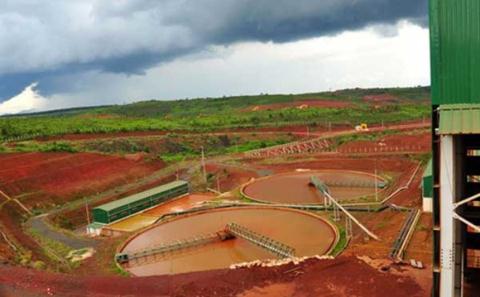
Scientists from the Vietnam Science and Technology Academy have confirmed that they can make iron from red mud, the waste created during alumina production.
 Deputy Prime Minister Hoang Trung Hai officially reported to the National Assembly’s Standing Committee at a meeting last Wednesday that the red mud generated from the Tan Rai and Nhan Co bauxite projects can be used to make steel and iron of a quality that meets Japanese standards.
Deputy Prime Minister Hoang Trung Hai officially reported to the National Assembly’s Standing Committee at a meeting last Wednesday that the red mud generated from the Tan Rai and Nhan Co bauxite projects can be used to make steel and iron of a quality that meets Japanese standards.
Finished iron samples derived of red mud from the Tan Rai factory were brought to the meeting and presented to the Standing Committee’s members.
According to Hai, this initial success has prompted Vietnam go further by organizing industrial production. If this project is fully realized, Vietnam would be able to heighten the efficiency of bauxite projects, reduce environmental pollution and produce marketable metals as well.
Elaborating on the plan to produce iron from red mud, Deputy Minister of Science and Technology Tran Van Tung said that, unlike that of other countries, the iron oxide concentrations in dry red mud in the Lam Dong Province of Vietnam are very high (between 46 and 53 percent), which means a total iron content of 35.7 percent. Therefore, the red mud there is considered poor iron ore, which can be used to make pig-iron and steel.
Besides, also according to Tung, Vietnam has large reserves of limestone, an important element in making pig iron and steel from red mud.
“These two factors can completely facilitate the production of steel and pig iron from red mud,” he concluded.
The Vietnam Science and Technology Academy was assigned to try producing iron. In the end, the scientists of the academy suggested two solutions, which both may later bring success and create iron.
However, only one has been chosen – the one which consumes less energy other, and brings high economic efficiency, thus allowing for production on an industrial scale. With this technology, wet red mud will be pressed to create dry residues.
“100 tons of dry mud was carried from Lam Dong Province to the Thai Nguyen Steel Mill in Hung Yen Province for processing. The scientists have used 50 tons and have successfully created iron,” Tung said, adding that this is a completely Vietnamese technology.
It is estimated that 2.4 tons of red mud, costing VND1.5 million, is enough to produce one ton of iron ore, with a market price of VND1.9 million. This means that it would be profitable to make iron ore from red mud. The profits are expected to be higher if making steel from the iron ores.
The news that Vietnam can make iron of red mud has piqued the interest of scientists and people. The question of how to deal with massive amounts of red mud byproduct was the main reason some analysts had protested the implementation of the two bauxite projects.
“Now we can say for sure that the red mud problem can be handled,” Tung stated. “We may not need the reservoirs to hold the red mud in the future, because it will be processed right after it comes out of the factories. The environmental problem will no longer be a worry, and we will have a new source of iron ore”.

 Previous page
Previous page Back to top
Back to top







